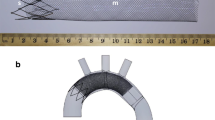Abstract
Embolic protective devices (EPD) are used in carotid angioplasty to reduce or prevent embolic debris from entering the brain and causing procedure-related strokes. In this chapter we analyze a proximal protection mechanism of EPD that performs cerebral protection by external and common carotid artery occlusion. The mathematical model we use is a one-dimensional (1D) equation system governing blood flow. This system is applied to a patient-specific arterial tree constructed from a 3D computed tomography angiography (CTA) image. We simulate the blood flow in both normal and procedural conditions. Wherever possible we compare our computation results with laboratory or previously published measurements and our model agrees with these data.
Access this chapter
Tax calculation will be finalised at checkout
Purchases are for personal use only
Similar content being viewed by others
References
Parodi, J.C., Ferreira, L.M., Sicard, G., Mura, R.L., Fernandez, S.: Cerebral protection during carotid stenting using flow reversal. Journal of Vascular Surgery, 41(3), 416–422 (2005)
Reimers, B., Sievert, H., Schuler, G.C., et al.: Proximal endovascular flow blockage for cerebral protection during carotid artery stenting: results from a prospective multicenter registry. Journal of Endovascular Therapy, 12, 156–165 (2005)
Cremonesi, A., Manetti, R., Setacci, F., et al.: Protected carotid stenting: clinical advantage and complications of embolic protection devices in 442 consecutive patients. Stroke, 34, 1936–1941 (2003)
Smith, N.P., Pullan, A.J., Hunter, P.J.: An anatomically based model of transient coronary blood flow in the heart. SIAM Journal of Applied Mathematics, 62(3), 990–1018 (2000)
Barnard, A.C., Hunt, W.A., Timlake, W.P., Varley, E.: A theory of fluid flow in compliant tubes. Biophysical Journal, 6, 718–724 (1966)
Alastruey, J., Parker, K., Peiro, J., Byrd, S., Sherwin, S.: Modelling the circle of Willis to assess the effects of anatomical variations and occlusions on cerebral flows. Journal of Biomechanics, 40, 1794–1805 (2007)
Long, Q., Luppi, L., Konig, C.S., Rinaldo, V., Das, S.K.: Study of the collateral capacity of the circle of Willis of patients with severe carotid artery stenosis by 3D computational modeling. Journal of Biomechanics, 41(12), 2735–2742 (2008)
Anderson, J.D.: Computational fluid dynamics: the basics with applications. McGraw-Hill, Inc., (1995)
Mills, C.J., Gabe, I.T., Gault, J.H., et al.: Pressure-flow relationships and vascular impedance in man. Cardiovascular Research, 4(4), 405–417 (1970)
Lindegaard, K.F., Nornes, H., Bakke, S.J., Sorteberg, W., Nakstad, P.: Cerebral vasospasm diagnosis by means of angiography and blood velocity measurements. Acta Neurochir (Wien), 100, 12–24 (1989)
Acknowledgments
We thank Prof. Juan Parodi of University of Miami for his explanation of the PAES procedure in e-mail transactions; we also thank the comments given by Mr. Gary Chaisson of Cardiovascular Institute of the South (Louisiana) regarding the procedure. We are grateful for the help from Dr. Kumar Mithraratne on 1D flow modeling.
Author information
Authors and Affiliations
Corresponding author
Editor information
Editors and Affiliations
Rights and permissions
Copyright information
© 2010 Springer Science+Business Media, LLC
About this paper
Cite this paper
Ho, H., Ladd, D., Holden, A., Hunter, P. (2010). Patient-Specific Hemodynamic Analysis for Proximal Protection in Carotid Angioplasty. In: Miller, K., Nielsen, P. (eds) Computational Biomechanics for Medicine. Springer, New York, NY. https://doi.org/10.1007/978-1-4419-5874-7_5
Download citation
DOI: https://doi.org/10.1007/978-1-4419-5874-7_5
Published:
Publisher Name: Springer, New York, NY
Print ISBN: 978-1-4419-5873-0
Online ISBN: 978-1-4419-5874-7
eBook Packages: EngineeringEngineering (R0)




